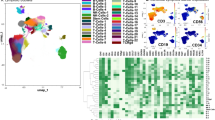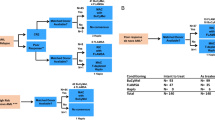Abstract
Following hematopoietic SCT (HSCT) for non-malignant disorders (NMDs) variable donor chimerism among lympho-hematopoietic lines may be observed. We retrospectively evaluated early post-HSCT, lineage-sorted (CD3+ and CD15+) peripheral blood leukocyte chimerism data to characterize patterns and assess for association with long-term CD15+ engraftment. ‘Early’ was defined as the first value obtained between days +14 and +42, ‘late’ as the last recorded value after day +90. ‘High’ donor chimerism was defined as ⩾80% on either fraction at all time-points. Patients were classified into four subgroups with respect to early CD3+/CD15+ chimerism patterns (high/low) then analyzed for long-term CD15+ chimerism status. A total of 135 transplants were evaluable, with all three time-points available in 97. Underlying disease, graft source, patient age and conditioning intensity varied. ‘Split’ early chimerism (discordant high/low CD3+/CD15+ status) was common. Multivariable analysis revealed strong association between conditioning regimen and primary disease on early CD3+/CD15+ chimerism patterns and a dominant predictive effect of early CD15+ chimerism on long-term CD15+ donor engraftment (observed at median day +365). These data may guide real-time clinician decisions (restraint vs intervention, when available) when faced with unfavorable or unusual early lympho-hematopoietic chimerism patterns following HSCT for NMD.
This is a preview of subscription content, access via your institution
Access options
Subscribe to this journal
Receive 12 print issues and online access
$259.00 per year
only $21.58 per issue
Buy this article
- Purchase on Springer Link
- Instant access to full article PDF
Prices may be subject to local taxes which are calculated during checkout

Similar content being viewed by others
References
Filipovich A . Hematopoietic cell transplantation for correction of primary immunodeficiencies. Bone Marrow Transplant 2008; 42 (Suppl 1): S49–S52.
Orchard PJ, Blazar BR, Wagner J, Charnas L, Krivit W, Tolar J . Hematopoietic cell therapy for metabolic disease. J Pediatr 2007; 151: 340–346.
Tolar J, Mehta PA, Walters MC . Hematopoietic cell transplantation for nonmalignant disorders. Biol Blood Marrow Transplant 2012; 18 (1 Suppl): S166–S171.
Mehta P, Locatelli F, Stary J, Smith FO . Bone marrow transplantation for inherited bone marrow failure syndromes. Pediatr Clin North Am 2010; 57: 147–170.
Locatelli F, Pagliara D . Allogeneic hematopoietic stem cell transplantation in children with sickle cell disease. Pediatr Blood Cancer 2012; 59: 372–376.
Wagner JE, Ishida-Yamamoto A, McGrath JA, Hordinsky M, Keene DR, Woodley DT et al. Bone marrow transplantation for recessive dystrophic epidermolysis bullosa. N Engl J Med 2010; 363: 629–639.
Gaziev J, Lucarelli G . Hematopoietic stem cell transplantation for thalassemia. Curr Stem Cell Res Ther 2011; 6: 162–169.
Walters MC, Patience M, Leisenring W, Rogers ZR, Aquino VM, Buchanan GR et al. Stable mixed hematopoietic chimerism after bone marrow transplantation for sickle cell anemia. Biol Blood Marrow Transplant 2001; 7: 665–673.
Aldenhoven M, Boelens JJ, de Koning TJ . The clinical outcome of Hurler syndrome after stem cell transplantation. Biol Blood Marrow Transplant 2008; 14: 485–498.
Miller WP, Rothman SM, Nascene D, Kivisto T, Defor TE, Ziegler RS et al. Outcomes following allogeneic hematopoietic cell transplantation for childhood cerebral adrenoleukodystrophy: the largest single-institution cohort report. Blood 2011; 118: 1971–1978.
Andreani M, Testi M, Gaziev J, Condello R, Bontadini A, Tazzari PL et al. Quantitatively different red cell/nucleated cell chimerism in patients with long-term, persistent hematopoietic mixed chimerism after bone marrow transplantation for thalassemia major or sickle cell disease. Haematologica 2011; 96: 128–133.
Marsh RA, Vaughn G, Kim MO, Li D, Jodele S, Joshi S et al. Reduced-intensity conditioning significantly improves survival of patients with hemophagocytic lymphohistiocytosis undergoing allogeneic hematopoietic cell transplantation. Blood 2010; 116: 5824–5831.
Antin JH, Childs R, Filipovich AH, Giralt S, Mackinnon S, Spitzer T et al. Establishment of complete and mixed donor chimerism after allogeneic lymphohematopoietic transplantation: recommendations from a workshop at the 2001 Tandem Meetings of the International Bone Marrow Transplant Registry and the American Society of Blood and Marrow Transplantation. Biol Blood Marrow Transplant 2001; 7: 473–485.
Acknowledgements
The article represents original research and analysis. It has not been submitted elsewhere, nor previously published. All authors have contributed to the manuscript in significant ways, have reviewed and agreed upon the manuscript content.
Author information
Authors and Affiliations
Corresponding author
Ethics declarations
Competing interests
The authors declare no conflict of interest.
Rights and permissions
About this article
Cite this article
Ketterl, T., Flesher, M., Shanley, R. et al. Early CD3+/CD15+ peripheral blood leukocyte chimerism patterns correlate with long-term engraftment in non-malignant hematopoietic SCT. Bone Marrow Transplant 49, 572–575 (2014). https://doi.org/10.1038/bmt.2013.207
Received:
Revised:
Accepted:
Published:
Issue Date:
DOI: https://doi.org/10.1038/bmt.2013.207
Keywords
This article is cited by
-
Allogeneic Reduced-Intensity Hematopoietic Stem Cell Transplantation for Chronic Granulomatous Disease: a Single-Center Prospective Trial
Journal of Clinical Immunology (2017)



